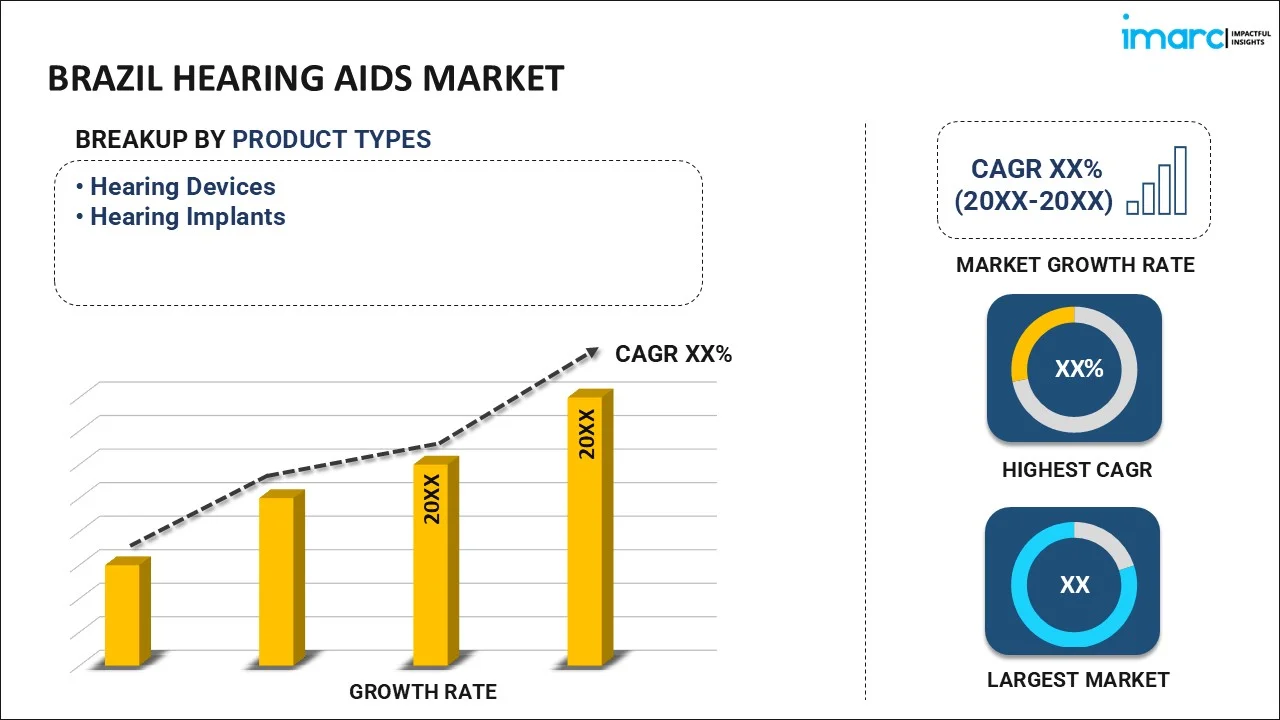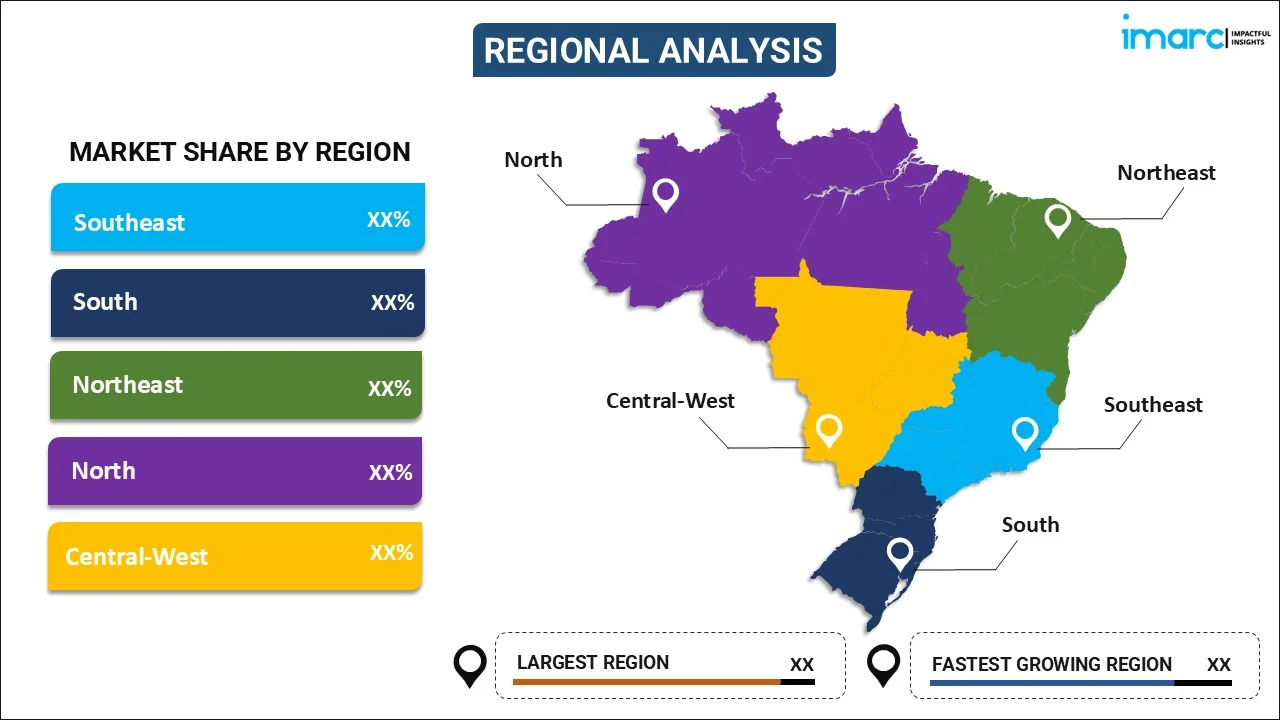
Brazil Hearing Aids Market Size, Share, Trends and Forecast by Product Type, Hearing Loss, Patient Type, Technology Type, and Region, 2026-2034
Brazil Hearing Aids Market Overview:
The Brazil hearing aids market size reached USD 122.9 Million in 2025. Looking forward, IMARC Group expects the market to reach USD 218.5 Million by 2034, exhibiting a growth rate (CAGR) of 6.60% during 2026-2034. The Brazil hearing aids market share is expanding due to the growing prevalence of hearing loss among the masses, integration of technological advancements, expanding government healthcare initiatives, rising geriatric population, and the increasing private healthcare services.
|
Report Attribute
|
Key Statistics
|
|---|---|
|
Base Year
|
2025
|
|
Forecast Years
|
2026-2034
|
|
Historical Years
|
2020-2025
|
| Market Size in 2025 | USD 122.9 Million |
| Market Forecast in 2034 | USD 218.5 Million |
| Market Growth Rate (2026-2034) | 6.60% |
Brazil Hearing Aids Market Trends:
Rising Prevalence of Hearing Loss
The growing incidence of hearing loss in Brazil, fueled by the growing geriatric population and exposure to noisy environments is consolidating the market growth in the nation. According to the World Health Organization (WHO), in Brazil, 1.1% of the population suffers from hearing impairment (HI). Out of these, 0.9% became deaf due to some disease or accident, and 0.2% were born deaf. In addition, the increased susceptibility of the geriatric population, as age-related hearing loss is prevalent among individuals in the age group of 65 and older, which is further propelling the market growth. Furthermore, increased rates of noise pollution in urban centers and work environments that aggravate hearing loss among younger populations is driving the market.
Rapid Technological Advancements in Hearing Aids
The launch of compact hearing aids with better features is favorably influencing the Brazil hearing aids market outlook. In addition, the growing incorporation of characteristics including Bluetooth technology connectivity, noise reduction, and directional microphones enables customers to listen more distinctively in cacophonous surroundings and connect their devices instantly to smartphones, televisions, and other electronic appliances is fortifying the hearing aids market in Brazil. Apart from this, the growing incorporation of artificial intelligence (AI) that allow hearing aids to learn and respond to users' individual hearing requirements and surroundings, turning the devices more personalized and efficient, is accelerating the growth of the market.
Imposition of Various Government Healthcare Initiatives
Imposition of government healthcare programs is driving Brazil hearing aids market growth. Together with this, the strong public healthcare system in the nation that renders core medical care to the people including audiological exams and hearing aids is developing a favorable market scenario throughout the region. Apart from this, the growing public subsidy for hearing aids, as the government seeks to enhance access to healthcare for the entire population, is driving the market expansion. Furthermore, the government of Brazil has been promoting campaigns to educate people about hearing loss, particularly among elderly adults. These campaigns are largely organized with complimentary hearing testing and make available public clinics where people can get a hearing aid at a discounted price.
Brazil Hearing Aids Market Segmentation:
IMARC Group provides an analysis of the key trends in each segment of the market, along with forecasts at the regional level for 2026-2034. Our report has categorized the market based on product type, hearing loss, patient type, and technology type.
Product Type Insights:

- Hearing Devices
- Behind-the-Ear (BTE)
- Receiver-in-the Ear (RITE)
- In-the-Ear (ITE)
- Canal Hearing Aids (CHA)
- Others
- Hearing Implants
- Cochlear Implants
- BAHA Implants
The report has provided a detailed breakup and analysis of the market based on the product type. This includes hearing devices [Behind-the-Ear (BTE), Receiver-in-the Ear (RITE), In-the-Ear (ITE), Canal Hearing Aids (CHA), others] and hearing implants [cochlear implants, BAHA implants].
Hearing Loss Insights:
- Sensorineural Hearing Loss
- Conductive Hearing Loss
A detailed breakup and analysis of the market based on the hearing loss have also been provided in the report. This includes sensorineural hearing loss and conductive hearing loss.
Patient Type Insights:
- Adults
- Pediatrics
A detailed breakup and analysis of the market based on the patient type have also been provided in the report. This includes adults and pediatrics.
Technology Type Insights:
- Analog
- Digital
A detailed breakup and analysis of the market based on the technology type have also been provided in the report. This includes analog and digital.
End User Insights:
- Hospitals
- ENT Clinics and Audiology Centers
- Individual
- Others
A detailed breakup and analysis of the market based on the end user have also been provided in the report. This includes hospitals, ENT clinics and audiology centers, individual, and others.
Regional Insights:

- Southeast
- South
- Northeast
- North
- Central-West
The report has also provided a comprehensive analysis of all the major regional markets, which include Southeast, South, Northeast, North, Central-West.
Competitive Landscape:
The market research report has also provided a comprehensive analysis of the competitive landscape. Competitive analysis such as market structure, key player positioning, top winning strategies, competitive dashboard, and company evaluation quadrant has been covered in the report. Also, detailed profiles of all major companies have been provided.
Brazil Hearing Aids Market News:
- In August 2025, Sonova Holding AG, a leading hearing aid company in Brazil, launched two new platforms under its primary brand, Phonak, namely Audéo Infinio and Audéo Sphere Infinio. This platform is dedicated for hearing aids and is built on a real-time artificial intelligence (AI) based technology platform. With this technology, Sonova has set new standards for sound quality, connectivity and power management, which are critical needs for people with hearing loss and it is also helpful in improving speech understanding and conversation quality.
- In May 2025, ADDvise announced that the company signed a Letter of Intent with the shareholders of Kolplast CI S.A. for the acquisition of all shares in Kolplast. The latter is a Brazilian manufacturer of MedTech equipment, such as hearing aids, based in São Paulo, Brazil. The company produces disposable medical devices, MedTech equipment, laboratory equipment, and liquid-based cytology products with over 8,000 active clients.
Brazil Hearing Aids Market Report Coverage:
| Report Features | Details |
|---|---|
| Base Year of the Analysis | 2025 |
| Historical Period | 2020-2025 |
| Forecast Period | 2026-2034 |
| Units | Million USD |
| Scope of the Report |
Exploration of Historical Trends and Market Outlook, Industry Catalysts and Challenges, Segment-Wise Historical and Future Market Assessment:
|
| Product Types Covered |
|
| Hearing Losses Covered | Sensorineural Hearing Loss, Conductive Hearing Loss |
| Patient Types Covered | Adults, Pediatrics |
| Technology Types Covered | Analog, Digital |
| End Users Covered | Hospitals, ENT Clinics and Audiology Centers, Individual, Others |
| Regions Covered | Southeast, South, Northeast, North, Central-West |
| Customization Scope | 10% Free Customization |
| Post-Sale Analyst Support | 10-12 Weeks |
| Delivery Format | PDF and Excel through Email (We can also provide the editable version of the report in PPT/Word format on special request) |
Key Questions Answered in This Report:
- How has the Brazil hearing aids market performed so far and how will it perform in the coming years?
- What is the breakup of the Brazil hearing aids market on the basis of product type?
- What is the breakup of the Brazil hearing aids market on the basis of hearing loss?
- What is the breakup of the Brazil hearing aids market on the basis of patient type?
- What is the breakup of the Brazil hearing aids market on the basis of technology type?
- What is the breakup of the Brazil hearing aids market on the basis of end user?
- What are the various stages in the value chain of the Brazil hearing aids market?
- What are the key driving factors and challenges in the Brazil hearing aids market?
- What is the structure of the Brazil hearing aids market and who are the key players?
- What is the degree of competition in the Brazil hearing aids market?
Key Benefits for Stakeholders:
- IMARC’s industry report offers a comprehensive quantitative analysis of various market segments, historical and current market trends, market forecasts, and dynamics of the Brazil hearing aids market from 2020-2034.
- The research report provides the latest information on the market drivers, challenges, and opportunities in the Brazil hearing aids market.
- Porter's five forces analysis assist stakeholders in assessing the impact of new entrants, competitive rivalry, supplier power, buyer power, and the threat of substitution. It helps stakeholders to analyze the level of competition within the Brazil hearing aids industry and its attractiveness.
- Competitive landscape allows stakeholders to understand their competitive environment and provides an insight into the current positions of key players in the market.
Need more help?
- Speak to our experienced analysts for insights on the current market scenarios.
- Include additional segments and countries to customize the report as per your requirement.
- Gain an unparalleled competitive advantage in your domain by understanding how to utilize the report and positively impacting your operations and revenue.
- For further assistance, please connect with our analysts.
 Request Customization
Request Customization
 Speak to an Analyst
Speak to an Analyst
 Request Brochure
Request Brochure
 Inquire Before Buying
Inquire Before Buying




.webp)




.webp)












